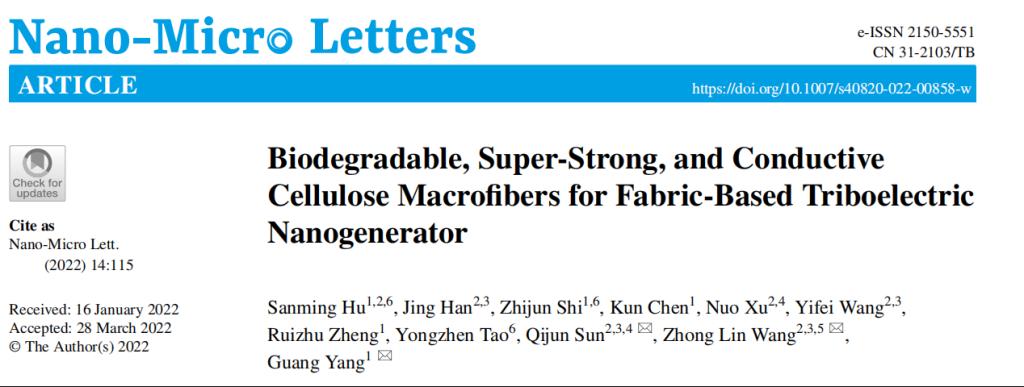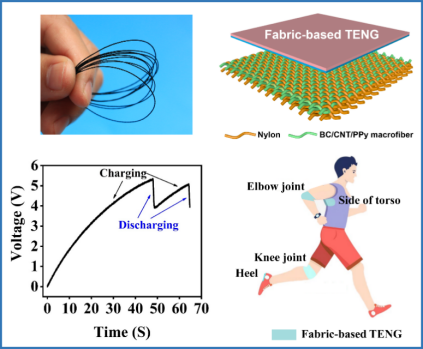The team of Professor Guang Yang of the School of Life achieved a series of achievements in the field of smart fabrics and environment-friendly self-powered sensors
On April 28, 2022, Professor Guang Yang, School of Life, Huazhong University of Science and Technology, cooperated with Academician Zhonglin Wang and Researcher Qijun Sun from the Beijing Institute of Nano-Energy and Systems Research, published a research paper entitled "Biodegradable, Super Strong, and Conductive Cellulose Macrofibers for Fabric Based Triboelectric Nanogenerator" in the international authoritative journal Nano-Micro Letters.

With the development of society and people's emphasis on health, it is of great significance to develop the smart fabrics for real-time monitoring of human motion status and energy supply for wearable electronic devices, which will lead people's lifestyles to a more functional, information-based, Humanized and intelligent. Triboelectric Nanogenerator (TENG) is a new energy-generating device that can convert the mechanical energy of low-frequency vibration changes into electrical energy. Compared with traditional electromagnetic generators, it has the advantages of simple structure design, wide selection of materials, low cost, high power density and high energy conversion efficiency. It has been widely studied in the fields of green energy harvesting, energy capture of body activity, power supply of portable electronic devices, personal health monitoring, and human-computer interface interaction. In terms of smart fabrics, TENG-based fabrics (fabric-based TENGs) can not only collect mechanical energy of human activities, but also serve as self-powered sensors to capture human activities and other information, which has potential applications in energy supply for wearable electronic devices and health monitoring. The conductive fibers for fabricating fabric-based TENGs have also been extensively studied. However, the conductive fibers currently used to prepare fabric-based TENGs are generally metal wires, carbon-based fibers and non-degradable polymer composite conductive wires, etc. It is difficult to take into account mechanical strength, washability, structural stability and environmental friendliness. Here, we reported a super-mechanically strong, biodegradable and washable cellulose-based conductive fiber thread. The fiber line is prepared by the method of stretching and wet twisting after doping and synthesizing conductive carbon nanotubes (CNTs) and polypyrrole (PPy) with the three-dimensional network structure of BC. The as-prepared cellulose-based conductive fiber threads exhibited high tensile strength of 449 MPa (capable of pulling up to 2 Kg in weight), good electrical conductivity (~5.32 S/cm), and excellent stability (tensile strength immersed in water for 1 day) and conductivity decreased by only 6.7% and 8.1%). Degradation experiments show that the fiber thread can be degraded within 108 hours under the action of cellulase. In terms of applications, the fabric-based TENG designed and fabricated from cellulose-based conductive fiber threads has a maximum open-circuit voltage of 170 V, a short-circuit current of 0.8 µA, and an output power of 352 µW, which can effectively charge capacitors and drive devices such as watches, thermohygrometers, and hygrometers. Operation of commercial electronic equipment such as calculators. In addition, the fabric-based TENG can be attached to human clothing as a self-powered sensor to effectively monitor human multi-state motion.

Figure 1: Schematic diagram of cellulose-based conductive fiber threads used to construct fabric-based TENGs and their applications
The first authors of this research paper are Hu Sanming, a PHD student at Huazhong University of Science and Technology, Han Jing, a PHD student at Beijing Institute of Nano Energy and Systems, and Dr. Shi Zhijun, Huazhong University of Science and Technology. Professor Guang Yang of Huazhong University of Science and Technology, Academician Zhonglin Wang and Researcher Qijun Sun of Beijing Institute of Nano Energy and Systems are the co-corresponding authors. This work has been supported by the BRICS Science and Technology Innovation Framework Program (3rd call 2019), the National Key R&D Program (Grant No. 2018YFE0123700), the National Natural Science Foundation of China (Grant No. 51973076 and 52073031), the National Key Laboratory of Textile New Materials and Advanced Processing Technology (Approval No.: FZ2021005) and special funds for basic scientific research business expenses of central universities (Approval No.: 2020kfyXJJS035, WUT2018IVB006, Z191100001119047), etc.
Paper link: http://doi.org/10.1007/s40820-022-00858-w
This work is another important achievement of Professor Guang Yang 's team in cellulose-based environment-friendly wearable biomedical sensors. In recent years, the team of Professor Yang Guang from Huazhong University of Science and Technology has done a series of work on cellulose-based environmentally friendly low-frequency energy harvesting devices and sensors. The team has published a number of research SCI papers in international mainstream academic journals such as ACS Applied Materials & Interfaces, Nano Energy, ACS Nano, Nano-micro Letters, etc. The potential of superhydrophobic liquid-solid contact triboelectric nanogenerators as droplet sensors for biomedical applications is expounded (ACS Applied Materials & Interfaces, 2019, cover paper), and an all-bacterial cellulose-based TENG is used to construct biodegradable environments Application of friendly human-computer interface interaction (Nano Energy, 2021), Bacterial cellulose/molecular ferroelectrics for constructing flexible biodegradable and recyclable piezoelectric sensors and applications with superior sensitivity (2022, ACS Nano ). This work is an extension and in-depth of the previous work, and clarifies the application prospect of bacterial cellulose in the preparation of washable, structurally stable and environmentally friendly smart fabrics.




